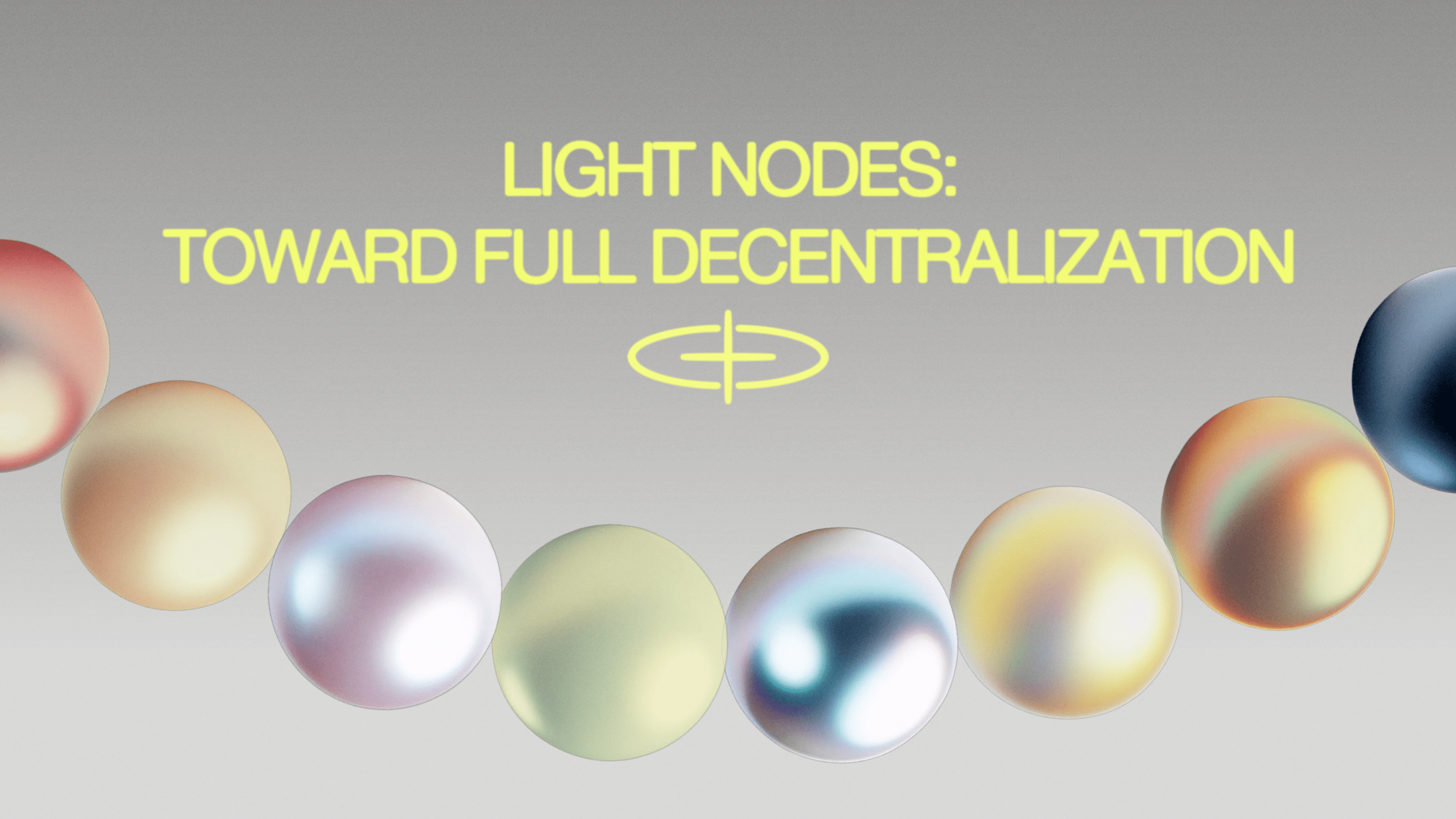Light Nodes: Toward Full Decentralization

Most blockchains are either fast and centralized, or inefficient and decentralized. And if users have to fork out a ton of cash to pay for the hardware needed to run nodes and validate transactions, decentralization becomes impossible.
While full decentralization may still be a pipedream, Sophon’s Light Nodes present an important step toward achieving this as they give regular users the chance to participate in securing the network - all without compromising scalability thanks to Sophon’s underlying infrastructure.
Built on Avail’s proven data availability framework, Sophon’s Light Nodes let everyday users set up and deploy their own node(s) for a fraction of the cost using standard hardware. This is all possible because of data availability sampling (DAS) which allows nodes to perform spot-checks instead of downloading the entire chain state - a much more lightweight process - and hence, “light” nodes.
This deep dive explains:
- Sophon’s Validium architecture
- How our Light Nodes work
- The tech that makes everything possible
- Why this matters
- What we plan to achieve in the future
Understanding Validiums
Sophon is a Validium, a kind of L2 architecture that enables high transaction throughput and low transaction fees since it performs calculations and uses data availability from Avail instead of Ethereum. Picture it like this:
Imagine a vault with a small deposit slot that’s very secure, but takes many people to open. Instead of opening it for every transaction, you keep a ledger where all deposits and withdrawals are recorded. To ensure accuracy, a network of random observers constantly checks these records, confirming that every transaction is correct and notifying you of any discrepancies. This system enables rapid processing without compromising security.
This is exactly how Validiums handle transactions off of Ethereum while staying secure. Unlike most blockchains that store all the details of every transaction on the L1, Validiums keep most of this data elsewhere (in Sophon’s case, on Avail).
Validiums offer several advantages:
- Faster Transactions: Validiums let L1s focus on important tasks while they deal with the smaller stuff, making everything faster.
- Lower Costs: By storing data elsewhere, Validiums avoid expensive transaction fees that come with keeping everything on Ethereum.
- More Flexible: Projects using Validiums can decide where and how they want to store their data (depending on their needs).
- Transaction Batching: Validiums can process transactions in batches, verifying them as a single unit, reducing costs and increasing network efficiency.
Think of Validiums as having Ethereum as your security guard while you keep your records in a separate location to save on costs. But there's a catch - you need to ensure data can always be accessed, because if something goes wrong, you need to be able to prove what belongs to who and recover everything.
This is where Sophon’s Light Nodes come in - instead of just blindly trusting where data is stored, we actively monitor things using our Light Nodes. Think of them as our eyes and ears, constantly checking that everything is where it’s supposed to be. This setup gives you the best of both worlds: the security of Ethereum and faster, cheaper transactions - all without sacrificing safety.
Sophon’s Light Nodes
Blockchains are made up of many nodes (high-powered computers) that help run and secure the network. Traditional nodes need specialized hardware to validate transactions as quickly and accurately as possible. This means they have to constantly download and process hundreds of gigabytes of data - think of it like needing the whole of Wikipedia just to verify the accuracy of one article - hardly efficient.
Light Nodes work very differently and are built for efficiency. Harnessing the power of Avail’s light clients, it’s now possible to prove that data is available to the network without everyone having to download everything. Avail’s light clients check random samples to verify block data - much like how a QA inspector checks a few items from a shipment to verify their quality instead of analyzing all the contents.
The good news is that light clients help to distribute work more evenly, meaning that more people can contribute, leading to greater decentralization and more democratic participation.
How It Works
Right now the way Sophon’s Light Nodes work is virtually identical to Avail’s light clients:
- When a new block is produced on Avail, a Light Node requests tiny random samples (cells) from the block.
- After the block is verified, block confidence is calculated as a percentage (%).
- If the confidence factor is above the percentage of certainty a user has set, the data in the block is considered to be available.
Thanks to Avail’s tech, if a Light Node is able to access its random samples without any trouble, there’s an overwhelming probability that all block data is available. Sophon plans to make this tech practical for everyday applications and accessible to a wider audience.
Why This Matters
Blockchains face a scaling issue that goes beyond processing transactions. Most networks rely on a few thousand validators with the high-end hardware needed to keep things running, and even then, they usually have to lock a lot of tokens in a staking contract to keep participating. Running a full node is expensive, resource-intensive and risky, making it out-of-reach for most people.
Sophon’s Light Nodes allow users with average hardware and little-to-no understanding of the tech to carry out valuable work for Sophon’s ecosystem. In this way, network operations aren’t centralized in the hands of a fortunate few - they can be fully decentralized as Light Node operators carry out work and earn rewards according to their individual contributions.
But this is just the start. In time we plan to enhance the functionality of Light Nodes so that builders can leverage powerful tools to create new experiences for users to enjoy.
Our Vision
As we shape the foundation for the next generation of the internet economy, Sophon is aligned with ZKsync's path toward progressive decentralization. Right now, Sophon operates the only Sequencer (Full Node) in the network, but in time, other parties will be able to run their own, leading to even greater decentralization and wider participation. This also applies to our centralized zero-knowledge Prover Node which allows us to generate zk proofs for all transactions and verify them on Ethereum - a crucial part of keeping our network secure.
Note that specifics are subject to ZKsync's roadmap and consensus design plans.
Conclusion
Ultimately Light Nodes will benefit builders, and in turn, the apps they create will be more intuitive, secure and accessible, allowing our users to enjoy high quality experiences without any hidden costs or downsides. And because of Sophon’s Validium architecture, our network can scale endlessly, eventually being made up not of thousands, but millions of participants.
By providing a means for everyday users to tap into the power of crypto without skimping on security or needing them to invest heavily, Sophon is redefining what blockchain networks are capable of.
The foundations are built. In time, we’ll create something truly unique that provides the best possible experience for builders and users alike. Full decentralization is on the horizon.
Let’s achieve it - together 🤝🏻
Always verify you're interacting with an official Sophon account, domain, or team member at verify.sophon.xyz
Disclaimer: This content is provided for informational purposes only, and should not be relied upon as legal, business, investment, financial or tax advice. You should consult your own advisers as to those matters. References to any digital assets and the use of finance-related terminology are for illustrative purposes only, and do not constitute any recommendation for any action or an offer to provide investment, financial or other advisory services. This content may not under any circumstances be relied upon when making a decision to purchase any digital asset referenced herein. The content speaks only as of the date indicated.

